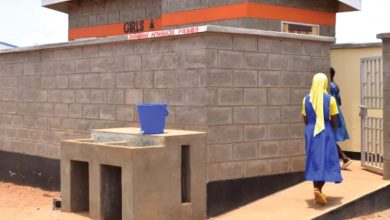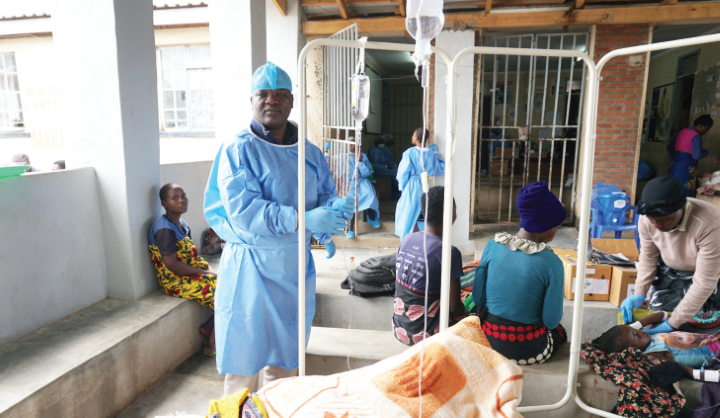Malaria hits Karonga flood survivors
Floods haunt Zindi Village in Karonga every year. When the tragedy struck in February, Lincy Mkwala quickly dispatched her three children to their granny and fled to a nearby church with the younger four. However, malaria is turning the escape into a jump from a frying pan.
“We thought we were safe, but our freedom was short-lived due to the spread of malaria in the camp,” the Kambitoto villager laments.

The killer disease, transmitted by mosquitoes, keeps haunting the children. Mosquitoes, which carry plasmodium, are rampant in the rice-growing communities chronically hit by floods. The waterlogged setting sprawls from Karonga Town to Songwe, the border with Tanzania. Thousands of Malawians live in huts that dot the marsh measuring about 45 kilometres (km) long.
In fact, almost 160 households from 10 villages under group village head Zindi were displaced by floods when North Rukuru River burst beyond its banks, destroying the houses, crops and other vital goods.
“It was tragic,” Mkwala recalls: “Some houses collapsed and others cracked. We run for our lives.”
Malaria presents a silent crisis among the survivors of the aftermath of heavy rains in Karonga and run-offs from Chitipa Hills.
For those camping in overcrowded churches at Zindi, the floods are gone, but they are not safe yet.
“Malaria is tormenting us because we do not have mosquito nets,” Lucy Mwagomba says.
During the visit, five children and two elders were bedridden by the disease which claims about four in every 10 Malawians dying in hospitals. According to the Ministry of Health, 40 out of 100 patients admitted to the health facilities are diagnosed with malaria.
The country’s health system, which is currently underfunded, high disease burdened, intermittently feeding the sick and short of skilled staff, reportedly handles nearly five million malaria cases a year.
At Zindi, a malarial child was seen vomiting in the bush while his parents waited for flour and other relief items from Northern Region Water Board (NRWB).
Organisations moved by the flood victims’ plight keep bringing relief items, but one thing is starkly missing in the packs-treated mosquito nets.
Without nets, mosquito bites go uncurbed in the prayer houses which take about 70 each.
“The church buildings are overcrowded like a prison,” camp leader Alick Mwamlima decries.
This makes the use of mosquito nets almost impossible. Congestion hits harder on rainy nights.
On dry nights, a few fleeing overcrowding sleep in open-air groups near a makeshift camp taking shape nearby.
Four weeks since the devastating floods, the dwarfed huts, made of wooden sticks, are neither thatched nor occupied. Wild plants are emerging on dusty floors as the stranded villagers are waiting for tents with no hope in sight.
To mothers, nets and tents will lessen the disease burden. Malaria is the leading cause of illness and death in under-five children in Karonga, says district health officer Dr Charles Sungani.
“The nets are a basic need. The risk of contracting malaria is high in Karonga and the cases that we see at the district hospital and 19 health centres often rise drastically during the rainy season,” Sungani says.
But malaria is not the only disease emerging in the congested camp. Ringworms and waterborne conditions, especially diarrhoea and dysentery, are also gaining sway.
The diseases caused by unsafe water and poor hygiene and sanitation compelled Red Cross to build toilets at the camp-with DfID, World Vision and Unicef joining hands to drill a borehole.
Karonga district commissioner Rosemary Moyo commends the organisations for intervening to lessen the humanitarian crisis, backing calls for efforts to safeguard the vulnerable cluster from opportunistic diseases.
When NRWB donated the flour and water treatment chemicals at Zindi, Moyo said: “When construction of toilets got underway, some people were overheard saying: ‘we need food first because one cannot use the toilet with an empty stomach.’ The people need many things, including a disease-free environment.”
The public health concern comes as government wants them to relocate from flood prone zones, but the victims are defiant.
Many say they just need a dyke to safeguard them from the silted river with numerous islands and blurred banks.
“We need to be protected from Rukuru or we will continue suffering. We are sick and tired of living like beggars,” argues Mwamlima. Karonga District Council’s urban development plan provides for construction of a dyke, but the DC says there are no financiers for the multimillion dollar project yet.
She stated: “A dyke needs billions of kwachas. With no funds in sight, it is risky for anyone to cling to flood-prone areas.”
Amid the conflict, Karonga Diocese Bishop Martin Mtumbuka’s words loom large.
“It is irresponsible and unthinkable for any government not to put dos and don’ts on where people can build and settle. The country cannot continue wasting billions of kwachas because it is failing to make sure people do not settle in waterways,” the outspoken Catholic bishop said when he handed over safe shelters for flood survivors to the council last year.
The houses lying in harm’s way have not been vacated. To Mkwala, the children grappling with malaria are silent victims of the choices right-thinking elders make.
She says: “We cannot continue living this way. We need to take necessary steps to protect lives.”





